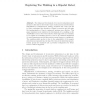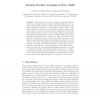149
click to vote
AMS
2007
Springer
15 years 5 months ago
2007
Springer
Abstract. This paper proposes a novel architecture for the programming of multi-modal service robots and networked sensors. The presented software framework eases the development o...
117
click to vote
AMS
2007
Springer
15 years 5 months ago
2007
Springer
Abstract In legged systems, springy legs facilitate gaits with subsequent contact and flight phases. Here, we test whether electrical motors can generate leg behaviors suitable for...
122
click to vote
AMS
2007
Springer
15 years 5 months ago
2007
Springer
When an outdoor mobile robot traverses different types of ground surfaces, different types of vibrations are induced in the body of the robot. These vibrations can be used to learn...
217
click to vote
AMS
2007
Springer
15 years 5 months ago
2007
Springer
Navigation and application functionality of mobile robots rely on their collision-avoiding capabilities, also known as local navigation. We present the mobile robot ARTOS (Autonomo...
119
click to vote
AMS
2007
Springer
15 years 7 months ago
2007
Springer
Abstract. In this this paper, we present a solution to the simultaneous localization and mapping (SLAM) problem for a robot equipped with a single perspective camera. We track extr...
125
click to vote
AMS
2007
Springer
15 years 7 months ago
2007
Springer
Abstract Walking, running and hopping are based on self-stabilizing oscillatory activity. In contrast, aiming movements serve to direct a limb to a desired location and demand a qu...
107
click to vote
AMS
2007
Springer
15 years 7 months ago
2007
Springer
The design and development of locomotory subsystems such as legs is a key issue in the broader topic of autonomous mobile systems. Simplification of substructures, sensing, actuat...
124
click to vote
AMS
2007
Springer
15 years 7 months ago
2007
Springer
Autonomous robots that can adapt to novel situations has been a long standing vision of robotics, artificial intelligence, and cognitive sciences. Early approaches to this goal du...
132
Voted
AMS
2007
Springer
15 years 7 months ago
2007
Springer
Abstract. In this paper we consider the problem of active mobile robot localization with range sensors in outdoor environments. In contrast to passive approaches our approach activ...





